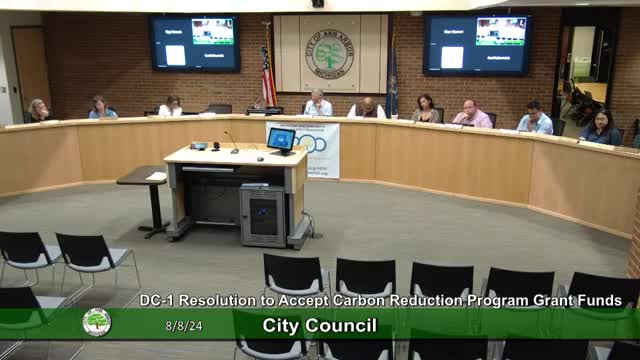City Council pushes for local control of dangerous roads
August 09, 2024 | Ann Arbor City, Washtenaw County, Michigan

This article was created by AI summarizing key points discussed. AI makes mistakes, so for full details and context, please refer to the video of the full meeting. Please report any errors so we can fix them. Report an error »

During a recent city council meeting, Ann Arbor officials discussed a resolution aimed at transferring control of state-owned roadways to the city, specifically focusing on improving safety and accessibility for cyclists and pedestrians. Councilmember Briggs initiated the discussion, referencing a tragic incident involving a cyclist on Washtenaw Avenue, which highlighted the dangers posed by poorly designed streets in the area.
Briggs emphasized that Washtenaw Avenue is classified as a \"tier one corridor\" in the city's Vision Zero transportation plan, which aims to reduce traffic-related fatalities and injuries. He noted that a staggering 77% of crashes occur on these high-risk corridors, underscoring the urgent need for local control over these roadways to implement necessary safety improvements.
The resolution seeks to negotiate with the Michigan Department of Transportation (MDOT) to assume responsibility for key streets, including Washtenaw, Huron, Jackson, and Main. Briggs argued that these corridors are vital not only for safety but also for achieving broader community goals such as climate neutrality, equity, and economic development. He pointed out that other cities, like Kalamazoo and Grand Rapids, have successfully taken similar steps to enhance their transportation infrastructure.
Councilmember Dish echoed Briggs' sentiments, expressing enthusiasm for the potential transformation of North Main Street, which currently functions more like a highway than a community-friendly thoroughfare. Dish highlighted the challenges faced by local businesses due to the road's design and speed, advocating for a safer environment for pedestrians and cyclists.
The council's discussions reflect a growing commitment to prioritize walkability and bikeability in Ann Arbor, aiming to create a more inclusive and safer urban landscape. The resolution is expected to pave the way for significant changes in how the city manages its transportation corridors, aligning with its long-term vision for sustainable urban development.
Briggs emphasized that Washtenaw Avenue is classified as a \"tier one corridor\" in the city's Vision Zero transportation plan, which aims to reduce traffic-related fatalities and injuries. He noted that a staggering 77% of crashes occur on these high-risk corridors, underscoring the urgent need for local control over these roadways to implement necessary safety improvements.
The resolution seeks to negotiate with the Michigan Department of Transportation (MDOT) to assume responsibility for key streets, including Washtenaw, Huron, Jackson, and Main. Briggs argued that these corridors are vital not only for safety but also for achieving broader community goals such as climate neutrality, equity, and economic development. He pointed out that other cities, like Kalamazoo and Grand Rapids, have successfully taken similar steps to enhance their transportation infrastructure.
Councilmember Dish echoed Briggs' sentiments, expressing enthusiasm for the potential transformation of North Main Street, which currently functions more like a highway than a community-friendly thoroughfare. Dish highlighted the challenges faced by local businesses due to the road's design and speed, advocating for a safer environment for pedestrians and cyclists.
The council's discussions reflect a growing commitment to prioritize walkability and bikeability in Ann Arbor, aiming to create a more inclusive and safer urban landscape. The resolution is expected to pave the way for significant changes in how the city manages its transportation corridors, aligning with its long-term vision for sustainable urban development.
View full meeting
This article is based on a recent meeting—watch the full video and explore the complete transcript for deeper insights into the discussion.
View full meeting
